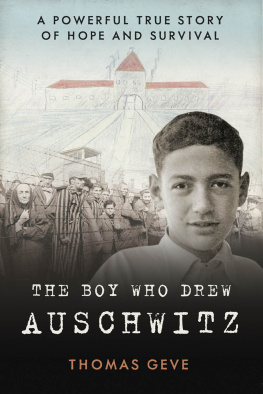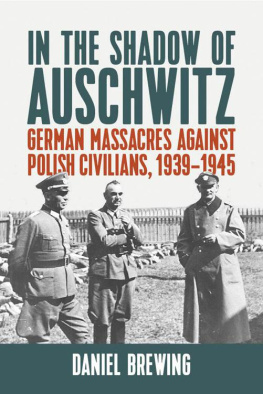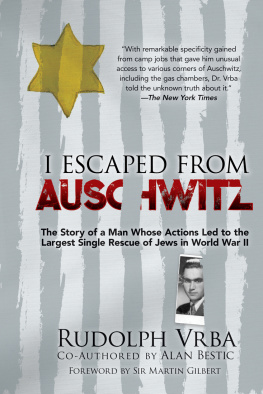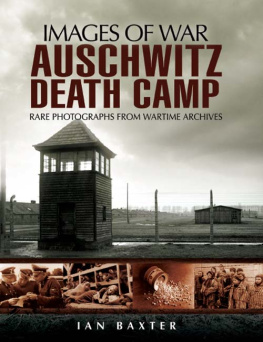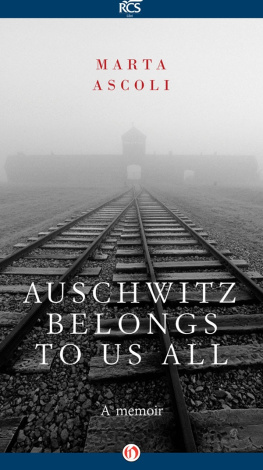Thomas Geve - The Boy Who Drew Auschwitz
Here you can read online Thomas Geve - The Boy Who Drew Auschwitz full text of the book (entire story) in english for free. Download pdf and epub, get meaning, cover and reviews about this ebook. year: 2020, publisher: HarperCollins Publishers, genre: Non-fiction. Description of the work, (preface) as well as reviews are available. Best literature library LitArk.com created for fans of good reading and offers a wide selection of genres:
Romance novel
Science fiction
Adventure
Detective
Science
History
Home and family
Prose
Art
Politics
Computer
Non-fiction
Religion
Business
Children
Humor
Choose a favorite category and find really read worthwhile books. Enjoy immersion in the world of imagination, feel the emotions of the characters or learn something new for yourself, make an fascinating discovery.
- Book:The Boy Who Drew Auschwitz
- Author:
- Publisher:HarperCollins Publishers
- Genre:
- Year:2020
- Rating:4 / 5
- Favourites:Add to favourites
- Your mark:
- 80
- 1
- 2
- 3
- 4
- 5
The Boy Who Drew Auschwitz: summary, description and annotation
We offer to read an annotation, description, summary or preface (depends on what the author of the book "The Boy Who Drew Auschwitz" wrote himself). If you haven't found the necessary information about the book — write in the comments, we will try to find it.
The Boy Who Drew Auschwitz — read online for free the complete book (whole text) full work
Below is the text of the book, divided by pages. System saving the place of the last page read, allows you to conveniently read the book "The Boy Who Drew Auschwitz" online for free, without having to search again every time where you left off. Put a bookmark, and you can go to the page where you finished reading at any time.
Font size:
Interval:
Bookmark:
HarperCollinsPublishers
1 London Bridge Street
London SE1 9GF
www.harpercollins.co.uk
Originally published as Youth in Chains in 1958 and Guns & Barbed Wire in 1987
This updated illustrated edition first published by HarperCollinsPublishers 2021
FIRST EDITION
Text and drawings Thomas Geve 2021
All original artworks by Thomas Geve, holder of the copyrights thereof, are part of Yad Vashem Art Museum collection. Photographs of the drawings Yad Vashem Art Museum, Jerusalem
Maps by Lovell Johns HarperCollinsPublishers Ltd 2021
Photographs courtesy of the author with the following exceptions: United States Holocaust Memorial Museum, .
Cover design HarperCollinsPublishers 2021
Cover photographs: Courtesy the author (author as a child); all original artworks by Thomas Geve, holder of the copyrights thereof, are part of Yad Vashem Art Museum Collection. Photo: Yad Vashem Art Museum, Jerusalem; Galerie Bilderwelt/Hulton Archive/Getty Images (Auschwitz survivors, front).
A catalogue record of this book is available from the British Library
Thomas Geve asserts the moral right to be identified as the author of this work
All rights reserved under International and Pan-American Copyright Conventions. By payment of the required fees, you have been granted the nonexclusive, non-transferable right to access and read the text of this e-book on screen. No part of this text may be reproduced, transmitted, downloaded, decompiled, reverse engineered, or stored in or introduced into any information storage retrieval system, in any form or by any means, whether electronic or mechanical, now known or hereinafter invented, without the express written permission of HarperCollins e-books.
Find out about HarperCollins and the environment at www.harpercollins.co.uk/green
Source ISBN: 9780008406387
Ebook Edition Jan 2021 ISBN: 9780008406400
Version: 2020-12-16
In memory of:
Eva-Ruth
Sally
Jonathan
Little Kurt
Long Kurt
Blond Gert
Saucy Gert
Ello, a lad from Slovakia
Mendel, a lad from Bialystok
Jendroe, a lad from Bohemia
Maurice, a lad from Salonika
Leo, a Dutchman
Poldi, a Swiss
Mr Pollack, a Czech
Block doctor 7a, a Belgian
Sigi, room-elder 7a, a German
Block-elder 7a, a German
Camp hairdresser, a German
Chapter 1
Stettin and Beuthen 192939
Chapter 2
Berlin 193940
Chapter 3
Berlin 19412
Chapter 4
Liquidation 1943
Chapter 5
Auschwitz-Birkenau
Chapter 6
Quarantine
Chapter 7
Bricklaying school
Chapter 8
Surviving
Chapter 9
Exhaustion
Chapter 10
Desperation
Chapter 11
Kindness among chaos
Chapter 12
A veteran now
Chapter 13
The wind of change
Chapter 14
Retreat from liberty
Chapter 15
Gross-Rosen camp
Chapter 16
Evacuation
Chapter 17
Buchenwald camp
Chapter 18
Free at last
It was often said that survivors of the Holocaust were silent after the Second World War. True, for many it was a suffering too painful to recount, and for some it remains so to this very day. But many did want to speak. They had promised their fellow inmates, most of whom did not survive, that they would bear witness and tell the world. And so they tried, only to encounter a world unable and often unwilling to hear. Survivors of the Holocaust were not silent. They were silenced.
Thomas Geve was among those who attempted immediately after the Holocaust to explain in detail what had just happened. At first, he simply wanted to tell his father, through an album of drawings. His father had been in England during the Second World War and could never imagine what his child had been through. Then Thomas wrote down his experiences for publication, only to be disappointed. But he did not give up. For over seventy-five years he has told the story you are about to read, a story that will take you deep into the terrifying world of the Nazi concentration camp system, where children, like him, were its prey.
Thomas Geve is a remarkable documentarian. His determination to detail what happened in the death and work camps in the Nazi concentration camp world reaches back into Auschwitz itself, where he found charcoal and scraps of cement sacks he was in the bricklaying Commando and sketched what happened there in real time. The original sketches did not survive, but the memory of what was on those scraps of paper remained in his mind, and immediately after the war, he began to draw again. He saw that other former inmates were documenting what had happened. He had his own facts to share. Somehow, the 13-year-old in Auschwitz had the presence of mind to pay attention to the details to check, measure, count and memorise. He had remembered the daily routine by the hour, the ration portions to the gram. Even the colours of the badges the prisoners wore were committed to his minds eye.
It seems that Geve perceived something at his tender age that adults many years his senior took much longer to realise: the minute detail of how the concentration camp system worked is key to understanding the nature of the crime itself. Through his innate curiosity, he understood that the malfeasance was so unbelievable that it may in fact not be believed, or that details could one day be erased. He was right of course: the role of Auschwitz-Birkenau at the heart of industrialised state-sanctioned genocide resulted in over a million Jews being gassed in carefully designed facilities. It was and remains unprecedented, and deserves our attention, but it was not all that happened there. Wrapped around those killing facilities was an entire machinery of sadistic daily torture and depravation. The Nazis not only murdered their victims; they created an entire system to make them suffer. That is what Geve documented first in his drawings, then in his text.
I have observed that there is a stickiness to testimony. The facts that survivors recount in their testimonies do not drift as much as one might imagine over time. I have also observed that the sooner after events accounts were documented, the more likely they are to reveal the precise nuances of the individuals own direct experience, without the overlay of later tropes and reader expectations. Geves testimony is a case in point. His first drawings were sketched in Auschwitz in 1944, followed in 1945 by the full set of more than eighty, many of which you will encounter in this book. He then wrote an accompanying narrative in 1947, when the memories were still vivid and not interpolated with later reflection, published in 1958 as Youth in Chains. Through the immediacy of Geves account, we get close and personal details of other inmates characters, including the friends he made and lost. We learn about the moral ambiguity within the inmate hierarchy, and the pervasiveness of sexual violence among the prisoner population, both of which are often muted in accounts that survivors gave later. We also learn of the power of friendship and the sacrifices made to help each other survive. Though it is well known that some prisoners cooperated for survival, especially in the womens sections, I have never heard testimony of a four-way food pact such as he and three of his friends created. Aspects of his story are positive in ways that are new and insightful.
Geves arrival at Auschwitz is chillingly and correctly recounted. For miles, I could see no trees, just empty fields. A mist rose in the distance, doubtless hiding whatever was lurking there and waiting for us. Geve accurately describes his arrival at Auschwitz at the little-known
Font size:
Interval:
Bookmark:
Similar books «The Boy Who Drew Auschwitz»
Look at similar books to The Boy Who Drew Auschwitz. We have selected literature similar in name and meaning in the hope of providing readers with more options to find new, interesting, not yet read works.
Discussion, reviews of the book The Boy Who Drew Auschwitz and just readers' own opinions. Leave your comments, write what you think about the work, its meaning or the main characters. Specify what exactly you liked and what you didn't like, and why you think so.

